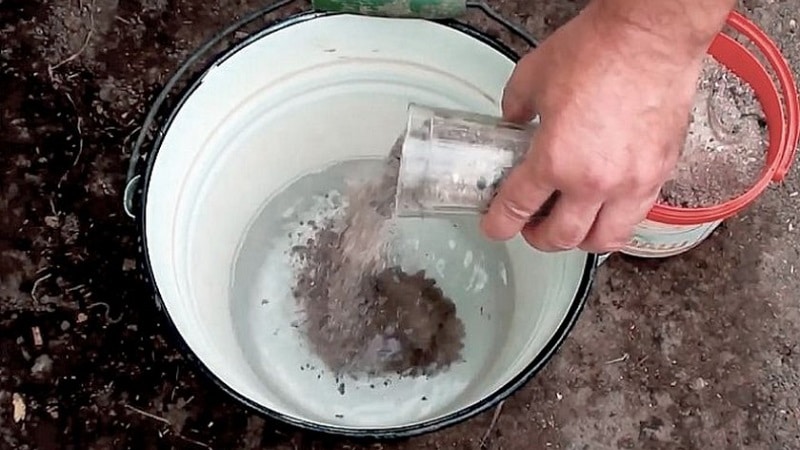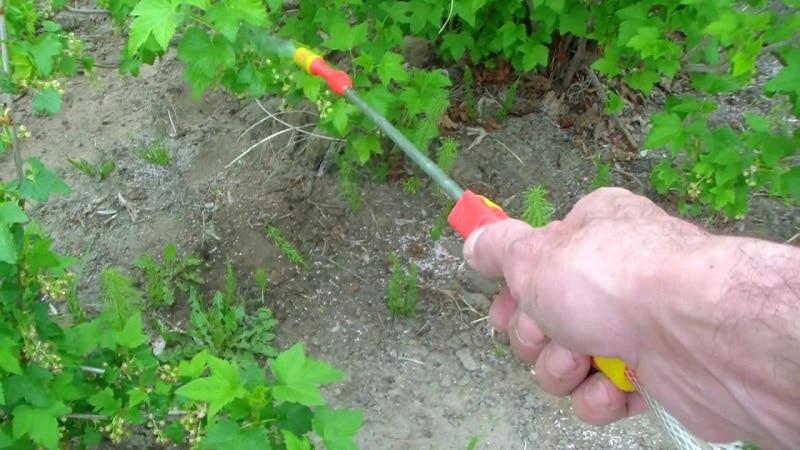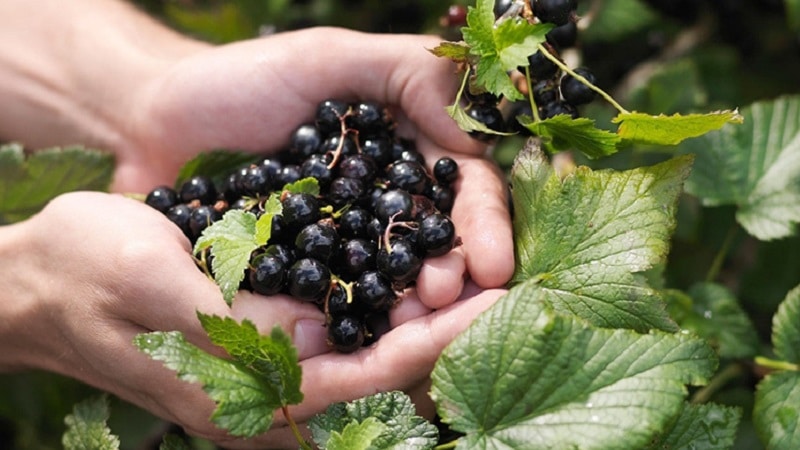What is good for currant ash and how to use it with maximum benefit
Wood ash - biological fertilizer, accessible to every gardener and gardener. It contains macro- and microelements in an easily digestible form. There is no chlorine in the ash, which is important for soil and plants, including currants. The substance is used to feed plants throughout the growing season. Thanks to its insecticidal effect, gardeners can easily get rid of pests on the site.
Proper use of ash also reduces the risk of currant infection with fungal diseases. In this article we will tell you why ash is good for currants, whether it is possible to sprinkle the bushes with dry matter, how to prepare an infusion and solution, and when to carry out the treatment.
Is it possible to use ash for currants?
Ash is a popular means among gardeners for feeding currants, preventing infectious diseases, and deoxidizing the soil, which is important when planting bushes on peat bogs and marshy substrates.
The substance can be obtained independently after burning wood, pine needles, and plant residues. The composition includes almost all the necessary minerals and, most importantly, there is no chlorine, which harms currants.

The product is easy to work with, it does not have an unpleasant odor and is absolutely safe for humans, it is stored for a long time and even after 3-5 years does not lose its nutritional and beneficial properties.
Reference. For currants, you cannot use residues obtained after the combustion of household waste.
What does this additive give to black, red, white currants?
Ash contains minerals such as potassium, calcium, magnesium, phosphorus, sulfur, boron, manganese. The most useful is obtained from buckwheat and rye straw, as well as the stem part of sunflower. But gardeners often use ash from deciduous wood (linden, birch) and pine needles. In stores, you mainly find ash from peat and coal, but it contains little potassium and phosphorus.
Ash reduces the acidity of the soil due to carbon dioxide in the composition, saturates it with microelements, increases the immunity of currants, as well as resistance to insect attacks.
Pros and cons of use
Benefits of ash:
- universal fertilizer;
- can be mixed with minerals and organic matter (humus, mullein);
- has insecticidal properties;
- increases plant immunity;
- improves the taste of berries;
- normalizes soil acidity;
- works best when mixed with soap, mustard, tobacco dust;
- can be stored for more than 10 years without loss of properties in metal or glass containers in a dry place.
Ash has no disadvantages. However, it cannot be mixed with nitrogen-containing fertilizers (ammonium nitrate, urea). This leads to increased growth of green mass and slows down fruiting.
What soils is it suitable for?
Wood ash is suitable for soil with high acidity (pH greater than 7 units) and is especially effective in peat bogs and sandy areas. It can also be added in moderate quantities to any type of soil for autumn and spring digging and to the soil between rows.
Feeding time
Feeding can be carried out throughout the entire growing season of currants, as well as at the stage of rooting of planting material during reproduction. The exact operating time depends on weather conditions, soil conditions, feeding purposes, and the season.

in spring
In the spring, ash is applied at the stage of soil preparation for planting seedlings, preventive treatment against pests and diseases. The funds are deposited after the snow melts, during the period of bud formation and flowering, in dry form or mixed with water.
Ash enriches the soil with minerals and also prevents infections. Depending on the climatic characteristics of the growing region, fertilizing is carried out in April or early May.
The powder is applied in calm, dry weather, since rain quickly washes it away from the bushes and from the soil.
At the stage of planting seedlings, ash is mixed with river sand and added to the planting hole. Consumption per bush - 200 g, per 1 m² - 400 g.
In summer
In summer, ash is added at the stage of berry formation, then at the time of active fruiting. The last treatment is carried out during the harvest period. Phosphorus, which is contained in ash, increases resistance to frost, which is important when growing crops in regions with cold climates. Spraying and dusting against insects is carried out every 10 days.
How to use it correctly
One of the advantages of ash is that it can be used in any form: spraying, dusting, root feeding (spring and autumn). Specific proportions have been developed for each method.
Dry for bushes
Dry ash is poured under the bushes and incorporated into the soil while loosening. Consumption per bush is 450-500 g.
Spraying
The spraying method is used for foliar feeding, disease prevention and insect protection. To prepare the working solution you will need 200 g of ash per 10 liters of water.The mixture is shaken vigorously and poured into a watering can with a fine spray or garden sprayer. The solution is used to treat the soil, herbs, buds and berries. The work is carried out in dry weather and refrain from watering for 2 days.

Powdering
Powdering is considered the best way to process currants. The consumption for every 1 m² is 500 g. After dusting, the substance remains on the greenery, which does not harm the plant at all.
The procedure is performed in dry, windless weather, since even slight precipitation washes away the substance.
2-3 days after dusting, it is recommended to loosen the soil under the bushes and refrain from potassium-phosphorus fertilizing for a month.
Root feeding
Ash is used as a root feed for currants throughout the growing season. The first portion is applied when planting seedlings in open ground. The substance can also be used once every 2-3 months for routine loosening of row spacing and tree trunk circles. The second portion is applied in the fall at the stage of preparation for winter. The optimal consumption is 300 g per bush.
Fertilizer recipes
In gardening, several recipes are used for preparing working solutions and mixtures for processing currants based on ash. The main advantage of home remedies is the ability to combine different components for a more effective effect on the plant.
Cold water infusion
Cold water infusion is used for quick feeding during flowering and fruiting. One part of mullein or humus is mixed with 10 parts of water and 100 g of ash. The solution is poured under the root and sprayed on the leaves and branches. The nutrient mixture replenishes the deficiency of macroelements in the soil and stimulates the fruiting process.
Hot decoction with laundry soap
A decoction with the addition of laundry soap shavings is used to prevent and protect currants from diseases and pests. 10 liters of boiling water is poured into a bucket and 500 g of ash is added. The mixture is infused for 48 hours and immediately before use, 35 g of laundry or tar soap is added. Solution water the soil and spray the crown, branches and leaves.
Feeding application scheme
Standard application scheme:
- The first portion of fertilizing is applied at the moment of bud setting. 7–10 liters of solution are consumed per bush.
- The second portion is added after flowering in the form of an ash solution.
- An additional portion of ash is added by dusting throughout the entire growing season.
For disease prevention
Wood ash helps fight fungal and bacterial diseases. Dusting or watering with infusion destroys pathogenic microflora and actively fights diseases such as powdery mildew, anthracnose and rust. At the same time, the mineral composition of the soil is restored, and the risk of developing chlorosis due to a lack of potassium and phosphorus is reduced.

For pest control
The insecticidal effect of ash is used by gardeners to prevent and destroy insect pests. The dry substance is used to powder the bushes and spray the currants in the spring and throughout the summer.
The ash repels aphids, caterpillars and butterflies, as well as the bud mite - a carrier of terry. A lasting result can be achieved after 3-5 procedures performed at intervals of 10-14 days.
During the period of infection, the bushes are sprayed with a weakly concentrated infusion every day. This helps reduce the negative impact of insects.The substance is absolutely safe for humans and the environment; it is washed away during rains and irrigation. For severe infestations, frequent treatment is recommended.
In what cases is it better to refuse such fertilizer?
The use of natural substances has no contraindications, however, the use of ash should be abandoned if currant bushes are planted on acidic soil. It is not recommended to mix the product with nitrogen, since the components neutralize each other.
Advice from experienced summer residents
Take the advice of experienced gardeners to use wood ash more efficiently on your site:
- To increase the yield of currants, use an ash solution with the addition of iodine. This helps saturate the berries with vitamin C and has a positive effect on their color and taste. For 10 liters of water, take 10 drops of iodine and 100 g of ash. Spray the bushes before the buds open.
- To alkalize the soil, add 3 tbsp. ash under each bush.
- For spraying and watering, dilute 150 g of ash in 10 liters of water.
- Do not mix ash with superphosphate. In this case, a binding reaction of phosphorus occurs, after which it becomes insoluble. As a result, the plant experiences phosphorus starvation.
- Do not mix ash with lime, as this leads to excessive deoxidation of the soil. You should also not add ash to the soil after liming the area.
- If you can't buy ash in the store, prepare it yourself. Choose a location away from the canopy of trees or bushes. Place grass and branches into the fire in measured doses. You can also put a metal sheet on the ground and burn wood and plant waste on it so as not to injure the soil. Once the fire pit has cooled, collect the ashes in metal or glass containers.You can also use plastic bags, but do not tie them tightly.
- Store ash in a closed container in a dry and dark place.
Conclusion
Ash is a valuable and useful source of micro- and macroelements. It contains a lot of potassium and phosphorus, calcium, iron, magnesium, zinc and sulfur. But the main advantage of wood ash is the ease with which plants absorb nutrients.
The ash does not contain chlorine, which is important for currants, which do not tolerate it. The substance is used in dry form: the bushes are powdered and embedded in the soil for digging. Solutions in cold water and infusions in boiling water are also prepared from the ash. Treatment of bushes is carried out throughout the entire growing season: in the spring after the snow melts and when planting seedlings, in the summer - at the stage of berry formation, active fruiting, and also during the harvest period.